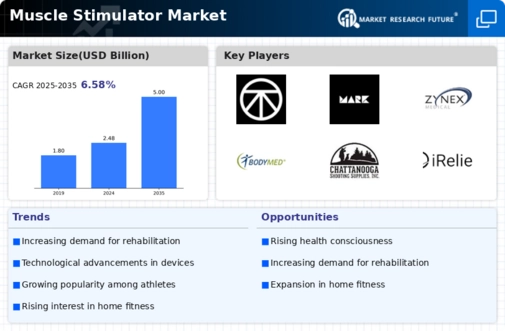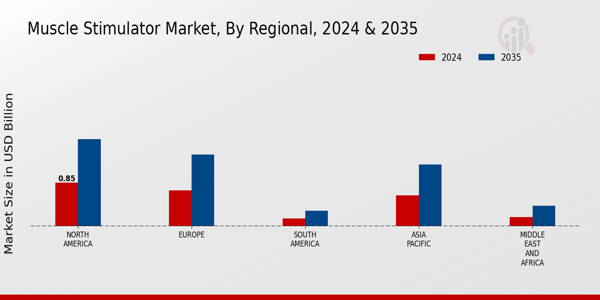Market Growth Projections
The Global Muscle Stimulator Market Industry is projected to experience substantial growth over the coming years. With a market value expected to reach 5 USD Billion by 2035, the industry is poised for expansion driven by various factors, including technological advancements, increasing health awareness, and the growing geriatric population. The compound annual growth rate (CAGR) of 6.58% from 2025 to 2035 indicates a robust market trajectory. This growth reflects the increasing adoption of muscle stimulators across various sectors, including healthcare, fitness, and rehabilitation, highlighting the diverse applications and benefits of these devices.
Growing Geriatric Population
The Global Muscle Stimulator Market Industry is significantly impacted by the growing geriatric population worldwide. As individuals age, they often experience muscle atrophy and decreased mobility, leading to an increased need for effective muscle stimulation therapies. Muscle stimulators provide a non-invasive solution to address these issues, making them increasingly popular among older adults. This demographic shift is expected to drive market growth, with the market projected to reach 2.48 USD Billion in 2024. The focus on improving quality of life for the elderly population aligns with broader healthcare initiatives aimed at enhancing mobility and independence.
Expansion of Home Healthcare Services
The Global Muscle Stimulator Market Industry is experiencing growth due to the expansion of home healthcare services. With an increasing number of patients preferring to receive care at home, muscle stimulators are becoming essential tools for home-based rehabilitation. This shift is supported by advancements in telehealth and remote monitoring technologies, which facilitate the use of muscle stimulators in home settings. As more individuals seek convenient and effective treatment options, the market is poised for growth. The trend aligns with the overall healthcare landscape, which is increasingly prioritizing patient-centered care and accessibility.
Rising Awareness of Health and Fitness
The Global Muscle Stimulator Market Industry is significantly influenced by the rising awareness of health and fitness among consumers. As individuals become more health-conscious, there is an increasing interest in fitness solutions that promote muscle recovery and enhance performance. Muscle stimulators are being recognized not only for rehabilitation but also for their potential benefits in sports and fitness training. This growing awareness is likely to drive market expansion, with a projected compound annual growth rate (CAGR) of 6.58% from 2025 to 2035. The integration of muscle stimulators into fitness regimens reflects a broader trend towards holistic health management.
Increasing Demand for Rehabilitation Solutions
The Global Muscle Stimulator Market Industry is witnessing a surge in demand for rehabilitation solutions, particularly among aging populations and individuals recovering from injuries. As healthcare systems evolve, there is a growing emphasis on non-invasive treatment methods that enhance recovery. Muscle stimulators are increasingly utilized in physical therapy settings, providing patients with effective pain relief and muscle re-education. This trend is expected to contribute to the market's growth, with projections indicating a market value of 2.48 USD Billion in 2024. The focus on rehabilitation aligns with broader healthcare initiatives aimed at improving patient outcomes and reducing recovery times.
Technological Advancements in Muscle Stimulation Devices
Technological innovations play a pivotal role in shaping the Global Muscle Stimulator Market Industry. Recent advancements in electrical stimulation technology have led to the development of more efficient and user-friendly devices. These innovations include wireless connectivity, programmable settings, and integration with mobile applications, enhancing user experience and treatment efficacy. As a result, healthcare providers and consumers are increasingly adopting these advanced muscle stimulators. The anticipated growth trajectory suggests that the market could reach 5 USD Billion by 2035, driven by the continuous evolution of technology and its application in therapeutic settings.



















